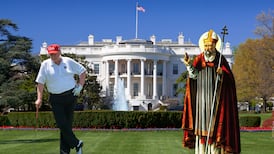IT SEEMS odd given Paul McCartney’s ties of blood and proximity to Ireland that his concert at the O2 on December 20th will be his first indoor solo appearance in this country.
In a career distinguished by its longevity and its enduring success, McCartney has only played Ireland four times, three times with The Beatles, all in 1963, and once as a solo performer at the RDS 40 years later.
We have become so accustomed, even spoiled, by a seemingly endless procession of his contemporaries such as The Rolling Stones, Bob Dylan and Brian Wilson visiting these shores that McCartney’s relative absence seems peculiar by comparison.
Quite why he left it 40 years to play Ireland is a bit of a mystery. “I’m working on it,” is as far as he went when asked the same question very politely by Irish fans who met him before his wedding at Castle Leslie, Co Monaghan in 2002. He was as good as his word when he played in 2003. McCartney prefaced his (sort of) RDS homecoming concert with a statement which said Ireland was “such a special place for me” though it was only in this decade that he made a real effort to reconnect with his Irish roots.
Ireland was certainly a special place for his mother Mary (Mohin) McCartney. Her father Owen Mohin (originally Mohan) was from Tullynamalrow in north Monaghan. He was born there in 1880 and emigrated to Glasgow at the age of 12 to become a coalman. There he met Mary Theresa Danher, the middle child of 14 children. Her father John Danher had been born in Ireland.
The couple moved to Liverpool and Mary Mohin was born in 1909. When she was 11 her mother died in childbirth. There would be a tragic symmetry to Mary Mohin McCartney’s life as she too would die prematurely, leaving a young family.
Mary spent some of her childhood living in Ireland as her father tried to make a new beginning in Monaghan after his wife died. Unfortunately, his time in Ireland coincided with the years of tumult surrounding the War of Independence and the Civil War and he was back in Liverpool within a couple of years.
He married again, this time an Irish woman called Rose (her surname remains a bit of a mystery) who would appear not to have got on with her stepdaughter.
Mary spent most of her teenage years living with her maternal aunts in Liverpool.
In 1941 she married James McCartney, a part-time musician, factory worker and war-time fire-fighter. He had seemed destined for a life of bachelorhood until he and his future wife were forced to take refuge from Hitler’s bombs in an air-raid shelter. McCartney’s antecedents had emigrated from Ireland in the 1850s.
Mary became a midwife in the hospital where her first son Paul was born in 1942. His parents were old by the standards of the time. James was 40, she 31 – an age when most contemporaries would have been resigned to the single life.
In 1944, Paul’s brother Michael was born. The McCartney family was
complete.
A portrait picture of McCartney’s mother shows her wearing a nurse’s veil. She looks almost saintly and certainly like a nun.
Unusually for her time, she was a working mother who earned more than her husband and become a ward nurse.
The two events that would transform the life of Paul McCartney for better and worse would happen within a year of each other when he was just 14.
McCartney’s mother was diagnosed with breast cancer in 1956. Within weeks she was dead from complications arising from treatment to prolong her life. Her last words, according to her sister-in-law, were to lament that she would not see her sons grow up.
Years later Michael McCartney would state that his brother’s first words when told of her death was “what are we going to do without her money?” Much has been made of this remark given the legendary parsimony the fabulously wealthy older brother would show in later life, but a more charitable reading of it is an irrational response of an immature teenager trying to deal with the unbearable awfulness of losing his mother.
In June the following year, McCartney met John Lennon at a church fair.
He too had an Irish grandfather, but, unlike McCartney, had a chaotic upbringing. He was abandoned by both his father and mother and was brought up by his aunt Mimi.
A year after he and McCartney met, Lennon’s mother Julia was killed in a car crash just after they had been reconciled as mother and son.
There is much speculation as to how the bonds of losing a mother early united the pair of budding geniuses. Those bonds may have been ineffable and even unspoken, but they were real enough.
McCartney's mother surfaces towards the end of The Beatles' career in the classic McCartney ballad Let It Be. The reference in the first line to Mother Mary can mean either his mother or the Virgin Mary.
McCartney’s mother was a strong Catholic. Her son’s views on religion were tempered by his father’s scepticism.
The song is interpreted as one about reconciliation and forgiveness, but its lyrics reflect the turmoil surrounding the then acrimonious relationship occurring in the band at the time with its reference to “times of trouble” and “hours of darkness” though McCartney’s sunny disposition surfaces later in the song.
After The Beatles split up, McCartney made a rare foray into politics (aside from his well-publicised vegetarianism). Give Ireland back to Irelandwas written after the Bloody Sunday killings in 1972, recorded and then released within a month. It is not his finest hour musically and certainly not lyrically where he hedged his bets with the lines "Great Britain you are tremendous/And nobody knows like me". Lennon also wrote two songs The Luck of the Irishand Bloody Sundaythat were much more unequivocal.
McCartney’s association with Monaghan will be forever associated with his ill-fated marriage in 2002 to the model Heather Mills. It is a shame, given that his decision to marry there was meant to be an attempt to honour the memory of his beloved mother.









